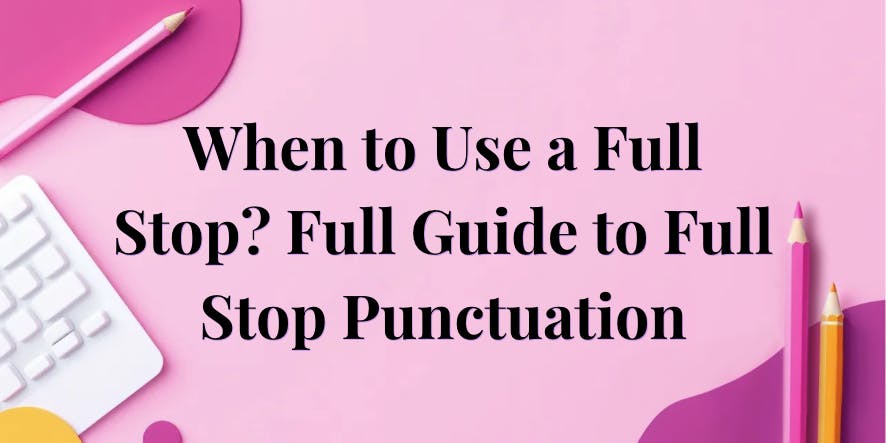Grammar and Punctuation
When to Use a Full Stop? Full Guide to Full Stop Punctuation
By Ben Long

A full stop, also called a period, is a basic but important part of English grammar. It marks the end of sentences and abbreviations, giving writing structure and clarity.
While it seems simple, the full stop plays a big role in preventing confusion. It separates ideas, making your message easier to understand.
In this article, we’ll explain what full stop punctuation means, where it comes from, and how to use it. You’ll also learn about common rules, exceptions, and examples that show why full stops are so important in clear communication.
TL;DR:
- Full stops are used to finish statements, indirect questions, and commands. They also separate items in lists and help break complex texts into easier-to-read sections.
- Using full stops correctly makes writing clear, readable, and grammatically accurate.
- Need help with full stops in your writing? Our online grammar checker can help you spot errors.
What Is A Full Stop In Writing? Full Stop Punctuation Meaning
A full stop, known as a period in North American English, is a fundamental punctuation mark in the written language. It signals the end of declarative sentences and is crucial in demarcating thoughts in writing.
By marking sentence boundaries, it helps to structure text clearly and effectively in English grammar. It’s a key answer to the question, “what is punctuation?”
In addition to ending sentences, a full stop is used after abbreviations. For instance, in British English, it punctuates truncations like "Mr." or "Dr."
Capitalization rules apply; the word following a full stop typically starts with a capital letter unless it is a lowercase proper noun.
Correct use of the full stop is vital for clear communication. Errors like using a full stop instead of a comma can obscure meaning. Thus, understanding its application ensures that writing is both grammatically correct and easily comprehensible to the reader.
When To Use A Full Stop Symbol: 7 Full Stop Punctuation Examples
A full stop, also referred to as a period, is crucial in punctuation. It marks the conclusion of a complete thought. Not using it right can lead to grammatical errors.
While commonly used at the end of declarative and imperative sentences, it also plays a role in other scenarios.
1. End of a Declarative Sentence
Full stops signify the end of declarative sentences, providing a clear indication that a statement is complete. For example: "The meeting starts at 10 AM."
2. End of an Imperative Sentence
Directives or commands require the use of a full stop to indicate the sentence's conclusion. For instance, "Close the window, please."
3. After Abbreviations
Full stops are used after certain abbreviations to signal the abbreviation's truncation. E.g., "Dr." for Doctor, "Inc." for Incorporated.
4. Following Initials
When initials represent a name or title, a full stop follows each letter. For example, "J.K. Rowling."
5. End of an Indirect Question
Sentences employing an indirect question format conclude with a full stop. Example: "She wondered why he left."
6. In Lists
Full stops are often used to separate points in a vertical list, assisting in organizing information.
7. Breaking Up Texts
In technical or academic writing, full stops can break complex texts into distinct, manageable statements. They ensure better clarity and comprehension.
These examples underline the versatility and necessity of full stops in maintaining sentence clarity and structure across various contexts.
Key Takeaways on Full Stop Punctuation
The full stop, or period, plays a crucial role in English grammar. It marks the end of sentences, separates ideas, and adds structure to writing. Knowing full stop meaning and examples helps writers improve clarity and readability.
For instance, a full stop in a sentence ensures each thought stands alone, avoiding confusion. Tools like the Hemingway Editor guide writers in using full stops effectively, promoting professional standards.
Mastering the full stop punctuation mark enhances communication, making it clear, precise, and easy to understand. Whether it’s defining full stops or applying them in context, accuracy is key. For extra assistance, don't miss our free grammar checker, which can help you spot and correct any mistakes.
FAQs
What Are The Functions Of A Full Stop?
A full stop, or period, primarily signifies the end of a sentence. It provides clarity by marking where an idea concludes, making text easy to navigate.
In addition to ending sentences, full stops are used in abbreviations such as "e.g." or "etc."
They are also employed in lists to denote the completion of items, though this is less common.
When to use a colon?
Many people wonder, "When to use a colon?" You use a colon to introduce a list, explain something further, or highlight an important idea. For example, a colon works well before items in a series or to separate a title and subtitle.
When Should You Not Use A Full Stop?
Avoid using a full stop in headings and titles where brevity is desired. In most cases, the title of articles, books, or papers should not include a full stop.
Also, refrain from placing full stops after headings in formal reports. They are unnecessary in lists written in informal contexts without complete sentences.
Period Vs Full Stop: What Is The Difference?
There is no actual difference between a period and a full stop; they refer to the same punctuation mark.
The term "full stop" is predominantly used in British English, while "period" is more common in American English.
Despite this, both terms share identical functions and uses in grammar across these regions.
What Does Full Stop Mean In Texting?
In texting, a full stop may carry an emotive function beyond marking a sentence's end. It might imply seriousness or finality, sometimes seeming abrupt or unfriendly.
Texts often omit full stops, relying on the line break to denote the end of a thought. As a result, its presence can change the tone of a message.